CFS2 > Page 11
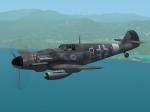
12.72Mb (3 downloads)
Messerschmitt Bf109G-6/R6 trop
by Design Team Daedalus
Unit: 7./JG27 Maleme, Crete December, 1943
Pilot: unknown
There is no "standard" Bf 109G-6, as the production run spanned 2 years it underwent many modifications and updates along the way. Tropical versions were delivered throughout the entire production run as the G-6 trop but displayed fewer variations. For example, I have not seen any G-6 trop aircraft fitted with an Erla Haube canopy while many G-6 versions were so fitted. The most obvious feature of the G-6 trop was the sand filter fitted to the front of the supercharger air intake. All G-6 trop aircraft had two small teardrop shaped clips on the port side below the canopy sill, which were mounts for a sun umbrella. The umbrella was intended to provide shade for the cockpit while the aircraft was at readiness. Different weapons packages could be seen like the 20mm under wing gondolas such as this aircraft was equipped with. Most Most G-6 trops were delivered to the Mediterranean operations areas and some to the southern Russian/Balkans front area.
Pstrany developed the models using Paul Rebuffat's Messerschmitt model - with permission - as a starting framework and updated the shape, and added a plethora of details, new parts, and ideas. Pstrany also developed the models for the drop tanks, weapons and racks.
Captain Kurt created paints for each, the 2D instrument panel, the individual .dp files, the air files and the aircraft.cfg files.
Mav SCASM edited each model so that they have animated wing slats, drop tanks, and other features, as well as optimizing models for the best possible framerates. Mav also developed the idea for the 2d panel to be offset for the Revi gunsight to match the CFS2 reticle.
Posted Oct 4, 2025 20:50 by Design Team Daedalus
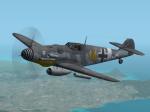
14.03Mb (4 downloads)
Messerschmitt Bf109G-6/R6 trop
by Design Team Daedalus
Unit: 12./JG3 San Severo, Italy August 1943
Pilot: unknown
There is no "standard" Bf 109G-6, as the production run spanned 2 years it underwent many modifications and updates along the way. Tropical versions were delivered throughout the entire production runs as the G-6 trop but had fewer variations. For example I have not seen any G-6 trop aircraft fitted with an Erla Haube canopy while many G-6 versions were so fitted. The most obvious feature of the G-6 trop was the sand filter fitted to the front of the supercharger air intake. All G-6 trop aircraft had two small teardrop shaped clips on the port side below the canopy sill, which were mounts for a sun umbrella. The umbrella was intended to provide shade for the cockpit while the aircraft was at readiness. Different weapons packages could be seen such as the 20mm under wing gondolas and more rarely, the WGr21 under wing rocket tubes such as equipped this aircraft. Most G-6 trops were sent to the Mediterranean operations areas and some to the southern Russian/Balkans front area.
Pstrany developed the models using Paul Rebuffat's Messerschmitt model - with permission - as a starting framework and updated the shape, and added a plethora of details, new parts, and ideas. Pstrany also developed the models for the drop tanks, weapons and racks.
Captain Kurt created paints for each, the 2D instrument panel, the individual .dp files, the air files and the aircraft.cfg files.
Mav SCASM edited each model so that they have animated wing slats, drop tanks, and other features, as well as optimizing models for the best possible framerates. Mav also developed the idea for the 2d panel to be offset for the Revi gunsight to match the CFS2 reticle.
We have all benefited from the assistance and guidance of others in the community, Special thanks to Wolfi and Huub Vink for their kind assistance and to all who have contributed their knowledge directly and indirectly.
Posted Oct 4, 2025 20:49 by Design Team Daedalus
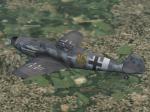
12.66Mb (6 downloads)
Messerschmitt Bf109G-6 trop
by Design Team Daedalus
Unit: 6./JG51 Either San Pietro, Italy, or on Sardinia during the summer of 1943
Pilot: unknown
There is no "standard" Bf 109G-6, as the production run spanned 2 years it underwent many modifications and updates along the way. Tropical versions were delivered throughout the entire production runs as the G-6 trop but had fewer variations. For example I have not seen any G-6 trop aircraft fitted with an Erla Haube canopy while many G-6 versions were so fitted. The most obvious feature of the G-6 trop was the sand filter fitted to the front of the supercharger air intake. All G-6 trop aircraft had two small teardrop shaped clips on the port side below the canopy sill, which were mounts for a sun umbrella. The umbrella was intended to provide shade for the cockpit while the aircraft was at readiness. Different weapons packages could be seen. Most Most G-6 trops were delivered to the Mediterranean operations areas and some to the southern Russian/Balkans front area.
Pstrany developed the models using Paul Rebuffat's Messerschmitt model - with permission - as a starting framework and updated the shape, and added a plethora of details, new parts, and ideas. Pstrany also developed the models for the drop tanks, weapons and racks.
Captain Kurt created paints for each, the 2D instrument panel, the individual .dp files, the air files and the aircraft.cfg files.
Mav SCASM edited each model so that they have animated wing slats, drop tanks, and other features, as well as optimizing models for the best possible framerates. Mav also developed the idea for the 2d panel to be offset for the Revi gunsight to match the CFS2 reticle.
Posted Oct 4, 2025 20:46 by Design Team Daedalus

12.76Mb (7 downloads)
Messerschmitt Bf109G-14
by Design Team Daedalus
Unit: III./JG76 W.Nr. 560593. Athis, France August, 1944.
Pilot: Hptm. Egon Albrecht-Lemke (He was a Brazilian of German ancestry who returned to Germany and joined the Luftwaffe scoring 25 aerial victories). He had a II./ZG1 wasp nose emblem as his unit was originally a Bf110 ground attack Gruppe on the East Front. II./ZG1 was then transferred to Defense of the Reich duties in early 1944. After heavy losses in July 1944, II./ZG1 converted to the Bf109G-14 and was redesignated III./JG76. Gruppenkommandeur Albrecht-Lemke then led the unit in missions over the Normandy invasion front. He was shot down by P-51s and KIA over Creil August 25, 1944.
The first Bf109G-14 fighters reached front line units in the summer of 1944. It was flown by virtually all of the Bf109 equipped units.
The G-14 version was an attempt to standardize a new type that would incorporate all of the plethora of changes introduced during the production of the G-6. The many changes and the ensuing problems associated with decentralized mass production had led to a great number of G-6 variations.
The effort was a complete failure because the G-14 wound up with as many variations as the G-6. Some had the small tail of the earlier G-6 while some had a tall rudder which came in several different versions. Some were wood, some were fabric covered, some had a rounded lower rear edge, some had a sharp angled rear edge and there were several variations of trim tabs. There were different antenna types and some had no antenna at all.
However there were some standards. It was powered by the DB605 AM engine with MW-50 injection and had the Erla Haube canopy. Most all had the FuG 16ZY radio with the antenna mast installed under the port wing outboard of the wheel well.
Pstrany developed the models using Paul Rebuffat's Messerschmitt model - with permission - as a starting framework and updated the shape, and added a plethora of details, new parts, and ideas. Pstrany also developed the models for the drop tanks, weapons and racks.
Captain Kurt created paints for each, the 2D instrument panel, the individual .dp files, the air files and the aircraft.cfg files.
Mav SCASM edited each model so that they have animated wing slats, drop tanks, and other features, as well as optimizing models for the best possible framerates. Mav also developed the idea for the 2d panel to be offset for the Revi gunsight to match the CFS2 reticle.
Posted Oct 4, 2025 18:19 by Design Team Daedalus

12.33Mb (3 downloads)
Messerschmitt Bf109G-14
by Design Team Daedalus
Unit: III/JG4
Pilot: unknown, unknown location, Germany, May 1945
The first Bf109G-14 fighters reached front line units in the summer of 1944. It was flown by virtually all of the Bf109 equipped units.
The G-14 version was an attempt to standardize a new type that would incorporate all of the plethora of changes introduced during the production of the G-6. The many changes and the ensuing problems associated with decentralized mass production had led to a great number of G-6 variations.
The effort was a complete failure because the G-14 wound up with as many variations as the G-6. Some had the small tail of the earlier G-6 while some had a tall rudder which came in several different versions. Some were wood, some were fabric covered, some had a rounded lower rear edge, some had a sharp angled rear edge and there were several variations of trim tabs. There were different antenna types and some had no antenna at all.
However there were some standards. It was powered by the DB605 AM engine with MW-50 injection and had the Erla Haube canopy. Most all had the FuG 16ZY radio with the antenna mast installed under the port wing outboard of the wheel well.
Pstrany developed the models using Paul Rebuffat's Messerschmitt model - with permission - as a starting framework and updated the shape, and added a plethora of details, new parts, and ideas. Pstrany also developed the models for the drop tanks, weapons and racks.
Captain Kurt created paints for each, the 2D instrument panel, the individual .dp files, the air files and the aircraft.cfg files.
Mav SCASM edited each model so that they have animated wing slats, drop tanks, and other features, as well as optimizing models for the best possible framerates. Mav also developed the idea for the 2d panel to be offset for the Revi gunsight to match the CFS2 reticle.
Posted Oct 4, 2025 18:17 by Design Team Daedalus

13.18Mb (3 downloads)
Messerschmitt Bf109G-14
by Design Team Daedalus
Unit: 16./JG53 W.Nr. 462892
Pilot: Gefr.Alfred Michel (POW). Shot down near Waldweistroff by US Army anti-aircraft fire during Operation Bodenpaltte January 1, 1945.
The first Bf109G-14 fighters reached front line units in the summer of 1944. It was flown by virtually all of the Bf109 equipped units.
The G-14 version was an attempt to standardize a new type that would incorporate all of the plethora of changes introduced during the production of the G-6. The many changes and the ensuing problems associated with decentralized mass production had led to a great number of G-6 variations.
The effort was a complete failure because the G-14 wound up with as many variations as the G-6. Some had the small tail of the earlier G-6 while some had a tall rudder which came in several different versions. Some were wood, some were fabric covered, some had a rounded lower rear edge, some had a sharp angled rear edge and there were several variations of trim tabs. There were different antenna types and some had no antenna at all.
However there were some standards. It was powered by the DB605 AM engine with MW-50 injection and had the Erla Haube canopy. Most all had the FuG 16ZY radio with the antenna mast installed under the port wing outboard of the wheel well.
Pstrany developed the models using Paul Rebuffat's Messerschmitt model - with permission - as a starting framework and updated the shape, and added a plethora of details, new parts, and ideas. Pstrany also developed the models for the drop tanks, weapons and racks.
Captain Kurt created paints for each, the 2D instrument panel, the individual .dp files, the air files and the aircraft.cfg files.
Mav SCASM edited each model so that they have animated wing slats, drop tanks, and other features, as well as optimizing models for the best possible framerates. Mav also developed the idea for the 2d panel to be offset for the Revi gunsight to match the CFS2 reticle.
Posted Oct 4, 2025 18:16 by Design Team Daedalus

49.48Mb (4 downloads)
Messerschmitt Bf109G-14
by Design Team Daedalus
Unit: 2./NAG 14 W.Nr. 463141
Pilot: unknown, surrendered at Furth-Atzenhof airfield on May 8, 1945. Although 2./NAG 14 was a short range reconnaissance unit, this aircraft was not equipped with cameras.
The first Bf109G-14 fighters reached front line units in the summer of 1944. It was flown by virtually all of the Bf109 equipped units.
The G-14 version was an attempt to standardize a new type that would incorporate all of the plethora of changes introduced during the production of the G-6. The many changes and the ensuing problems associated with decentralized mass production had led to a great number of G-6 variations.
The effort was a complete failure because the G-14 wound up with as many variations as the G-6. Some had the small tail of the earlier G-6 while some had a tall rudder which came in several different versions. Some were wood, some were fabric covered, some had a rounded lower rear edge, some had a sharp angled rear edge and there were several variations of trim tabs. There were different antenna types and some had no antenna at all.
However there were some standards. It was powered by the DB605 AM engine with MW-50 injection and had the Erla Haube canopy. Most all had the FuG 16ZY radio with the antenna mast installed under the port wing outboard of the wheel well.
Pstrany developed the models using Paul Rebuffat's Messerschmitt model - with permission - as a starting framework and updated the shape, and added a plethora of details, new parts, and ideas. Pstrany also developed the models for the drop tanks, weapons and racks.
Captain Kurt created paints for each, the 2D instrument panel, the individual .dp files, the air files and the aircraft.cfg files.
Mav SCASM edited each model so that they have animated wing slats, drop tanks, and other features, as well as optimizing models for the best possible framerates. Mav also developed the idea for the 2d panel to be offset for the Revi gunsight to match the CFS2 reticle.
Posted Oct 4, 2025 18:14 by Design Team Daedalus

12.55Mb (5 downloads)
Messerschmitt Bf109G-14
by Design Team Daedalus
Unit: 15./JG5
Pilot: unknown. Lister, Norway, May,1945
The first Bf109G-14 fighters reached front line units in the summer of 1944. It was flown by virtually all of the Bf109 equipped units.
The G-14 version was an attempt to standardize a new type that would incorporate all of the plethora of changes introduced during the production of the G-6. The many changes and the ensuing problems associated with decentralized mass production had led to a great number of G-6 variations.
The effort was a complete failure because the G-14 wound up with as many variations as the G-6. Some had the small tail of the earlier G-6 while some had a tall rudder which came in several different versions. Some were wood, some were fabric covered, some had a rounded lower rear edge, some had a sharp angled rear edge and there were several variations of trim tabs. There were different antenna types and some had no antenna at all.
However there were some standards. It was powered by the DB605 AM engine with MW-50 injection and had the Erla Haube canopy. Most all had the FuG 16ZY radio with the antenna mast installed under the port wing outboard of the wheel well.
Pstrany developed the models using Paul Rebuffat's Messerschmitt model - with permission - as a starting framework and updated the shape, and added a plethora of details, new parts, and ideas. Pstrany also developed the models for the drop tanks, weapons and racks.
Captain Kurt created paints for each, the 2D instrument panel, the individual .dp files, the air files and the aircraft.cfg files.
Mav SCASM edited each model so that they have animated wing slats, drop tanks, and other features, as well as optimizing models for the best possible framerates. Mav also developed the idea for the 2d panel to be offset for the Revi gunsight to match the CFS2 reticle.
Posted Oct 4, 2025 18:14 by Design Team Daedalus
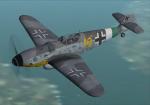
12.43Mb (5 downloads)
Messerschmitt Bf109G-14/U4
by Design Team Daedalus
Unit: 3./JG77 W.Nr. 512429
Pilot: unknown, force landed at Euskirchen, Germany, December, 1944 (?) Found by US troops in May, 1945
The first Bf109G-14 fighters reached front line units in the summer of 1944. It was flown by virtually all of the Bf109 equipped units.
The G-14 version was an attempt to standardize a new type that would incorporate all of the plethora of changes introduced during the production of the G-6. The many changes and the ensuing problems associated with decentralized mass production had led to a great number of G-6 variations.
The effort was a complete failure because the G-14 wound up with as many variations as the G-6. Some had the small tail of the earlier G-6 while some had a tall rudder which came in several different versions. Some were wood, some were fabric covered, some had a rounded lower rear edge, some had a sharp angled rear edge and there were several variations of trim tabs. There were different antenna types and some had no antenna at all.
However there were some standards. It was powered by the DB605 AM engine with MW-50 injection and had the Erla Haube canopy. Most all had the FuG 16ZY radio with the antenna mast installed under the port wing outboard of the wheel well.
Many G-14s built by WNF had 30mm nose cannons rather than the usual 20mm designated as the Bf109G-14/U4.
Pstrany developed the models using Paul Rebuffat's Messerschmitt model - with permission - as a starting framework and updated the shape, and added a plethora of details, new parts, and ideas. Pstrany also developed the models for the drop tanks, weapons and racks.
Captain Kurt created paints for each, the 2D instrument panel, the individual .dp files, the air files and the aircraft.cfg files.
Mav SCASM edited each model so that they have animated wing slats, drop tanks, and other features, as well as optimizing models for the best possible framerates. Mav also developed the idea for the 2d panel to be offset for the Revi gunsight to match the CFS2 reticle.
Posted Oct 4, 2025 18:10 by Design Team Daedalus
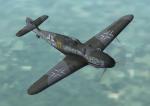
12.89Mb (6 downloads)
Messerschmitt Bf109G-14/U4
by Design Team Daedalus
Unit: 3./JG52
Pilot: unknown, Deutsch Brod, May, 1945.
The first Bf109G-14 fighters reached front line units in the summer of 1944. It was flown by virtually all of the Bf109 equipped units.
The G-14 version was an attempt to standardize a new type that would incorporate all of the plethora of changes introduced during the production of the G-6. The many changes and the ensuing problems associated with decentralized mass production had led to a great number of G-6 variations.
The effort was a complete failure because the G-14 wound up with as many variations as the G-6. Some had the small tail of the earlier G-6 while some had a tall rudder which came in several different versions. Some were wood, some were fabric covered, some had a rounded lower rear edge, some had a sharp angled rear edge and there were several variations of trim tabs. There were different antenna types and some had no antenna at all.
However there were some standards. It was powered by the DB605 AM engine with MW-50 injection and had the Erla Haube canopy. Most all had the FuG 16ZY radio with the antenna mast installed under the port wing outboard of the wheel well.
Many G-14s built by WNF had 30mm nose cannons rather than the usual 20mm designated as the Bf109G-14/U4.
Pstrany developed the models using Paul Rebuffat's Messerschmitt model - with permission - as a starting framework and updated the shape, and added a plethora of details, new parts, and ideas. Pstrany also developed the models for the drop tanks, weapons and racks.
Captain Kurt created paints for each, the 2D instrument panel, the individual .dp files, the air files and the aircraft.cfg files.
Mav SCASM edited each model so that they have animated wing slats, drop tanks, and other features, as well as optimizing models for the best possible framerates. Mav also developed the idea for the 2d panel to be offset for the Revi gunsight to match the CFS2 reticle.
Posted Oct 4, 2025 18:09 by Design Team Daedalus


